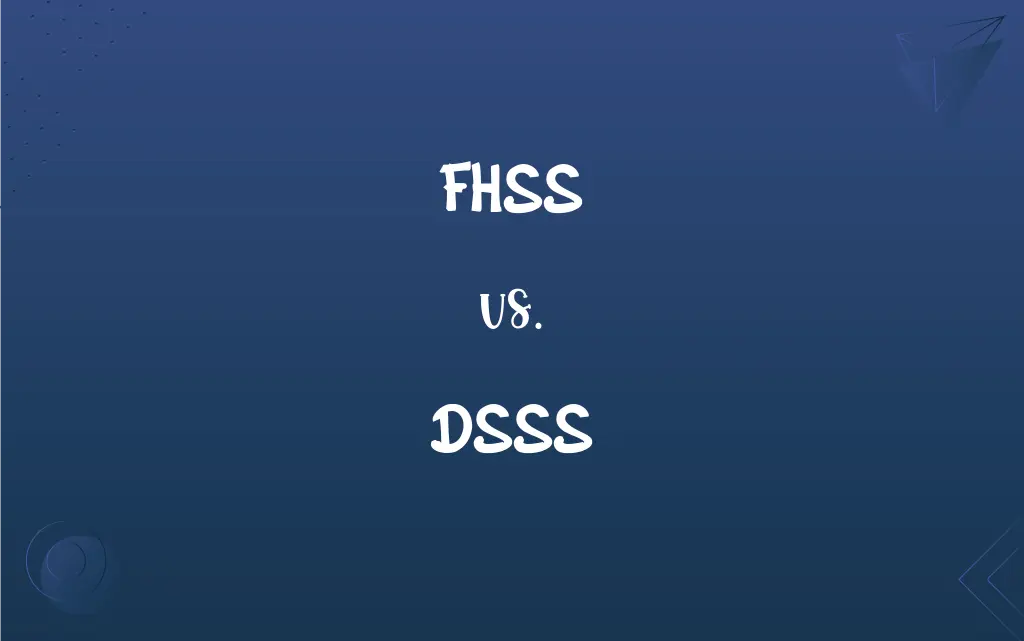FHSS vs. DSSS: What's the Difference?
Edited by Aimie Carlson || By Harlon Moss || Published on February 15, 2024
FHSS (Frequency-Hopping Spread Spectrum) changes frequencies during transmission, while DSSS (Direct-Sequence Spread Spectrum) spreads signals across a wider frequency.

Key Differences
FHSS, or Frequency-Hopping Spread Spectrum, involves rapidly switching frequencies during transmission, akin to hopping between channels. DSSS, Direct-Sequence Spread Spectrum, instead spreads the signal over a wider frequency band using a specific code, increasing signal robustness.
FHSS provides high resistance to interference and jamming, as the rapid frequency shifts make it difficult for unwanted signals to disrupt communication. In contrast, DSSS, by spreading its signal, inherently resists narrowband interference, making it more stable in cluttered signal environments.
Security in FHSS is enhanced through the unpredictability of frequency changes, making it harder for eavesdroppers to intercept. DSSS, while not inherently secure, can be combined with encryption techniques to ensure secure communication, leveraging its coding scheme for added protection.
FHSS typically uses less bandwidth for transmission, jumping across frequencies within a set range. DSSS, on the other hand, requires a broader bandwidth due to its spreading technique, which can be an issue in bandwidth-constrained environments.
The implementation of FHSS is generally simpler and more cost-effective, making it suitable for a range of applications. DSSS, with its need for complex processing to handle the spreading and unspreading of signals, tends to be more expensive and complex to implement.
ADVERTISEMENT
Comparison Chart
Frequency Utilization
Changes frequencies during transmission
Spreads signal over a wider frequency
Resistance to Interference
High due to frequency hopping
High due to signal spreading
Security
Enhanced through unpredictable frequency changes
Can be secured with additional encryption
Bandwidth Requirement
Lower, uses a range of frequencies
Higher, requires broad bandwidth
Implementation
Simpler and cost-effective
More complex and expensive
ADVERTISEMENT
FHSS and DSSS Definitions
FHSS
FHSS is a spread spectrum technique that changes frequencies in a predetermined sequence.
The drone's remote control uses FHSS to maintain a secure and uninterrupted control link.
DSSS
DSSS enables simultaneous transmission of multiple signals over the same frequency band.
In our office Wi-Fi network, DSSS allows multiple devices to connect without interfering with each other.
FHSS
FHSS enhances communication security and resistance to interference and jamming.
Our company's wireless network uses FHSS to prevent unauthorized access and ensure reliable data transfer.
DSSS
DSSS improves signal resistance to interference and eavesdropping by using a unique code for spreading.
The wireless security camera uses DSSS to prevent signal interception and ensure private video transmission.
FHSS
FHSS technology is commonly used in Bluetooth and wireless networks for efficient data transmission.
Bluetooth devices employ FHSS to maintain stable connections even in areas with heavy wireless traffic.
DSSS
DSSS technology requires more bandwidth but provides a higher degree of security and data integrity.
The company's wireless network uses DSSS to ensure reliable and secure communication over its wide coverage area.
FHSS
FHSS allows for multiple users to share the same spectrum without interference.
In our office, several wireless devices operate seamlessly using FHSS, avoiding cross-talk and interference.
DSSS
DSSS is a spread spectrum technique where a signal is spread across a wider bandwidth than necessary.
To enhance signal clarity, the communication system uses DSSS to spread its data over a wide frequency range.
FHSS
FHSS is a method of transmitting radio signals by rapidly switching among many frequency channels.
In military communications, FHSS is used to avoid detection and jamming by enemies.
DSSS
DSSS is widely used in Wi-Fi and GPS technologies for robust and secure data transmission.
Our GPS device relies on DSSS to receive clear signals even in areas with high radio frequency noise.
FAQs
What is FHSS?
Frequency-Hopping Spread Spectrum is a method where the transmission frequency is rapidly changed.
Is FHSS secure for communication?
Yes, due to its unpredictable frequency changes, it's more secure against eavesdropping.
What are the advantages of FHSS?
FHSS offers enhanced security, resistance to interference, and efficient use of bandwidth.
Where is FHSS commonly used?
In Bluetooth technology, military communications, and certain wireless networks.
How does FHSS improve signal reliability?
By hopping frequencies, it avoids interference and maintains a stable connection.
Can FHSS be used for long-distance communication?
It's more suited for short-range due to its rapid frequency changes.
Can DSSS be combined with encryption?
Yes, for enhanced security in data transmission.
Are FHSS and DSSS compatible with each other?
Generally, they operate independently due to their different spreading techniques.
Why is DSSS used in Wi-Fi?
It provides robust transmission, resistance to interference, and supports multiple users.
What is the main difference between FHSS and DSSS?
FHSS changes frequencies during transmission, while DSSS spreads the signal across a wider frequency.
What type of interference can DSSS withstand?
DSSS is particularly effective against narrowband interference.
Are FHSS and DSSS suitable for all wireless applications?
No, the suitability depends on specific requirements like range, bandwidth, and security needs.
What is DSSS?
Direct-Sequence Spread Spectrum spreads a signal over a wider frequency band than necessary.
Is DSSS bandwidth-efficient?
No, it requires more bandwidth compared to non-spread spectrum techniques.
How does FHSS handle network congestion?
FHSS mitigates congestion by hopping through different frequencies, reducing the chance of collision.
Can FHSS be used in mobile communications?
Yes, FHSS is suitable for mobile communications, offering flexibility and resistance to interference.
Does DSSS require complex hardware?
Yes, DSSS typically needs more complex hardware for signal spreading and processing.
Is DSSS affected by multipath fading?
DSSS is less affected by multipath fading due to its wide frequency spread.
How do FHSS and DSSS impact battery life in devices?
FHSS may consume less battery due to simpler technology, while DSSS might consume more due to its complex processing.
How does DSSS resist interference?
By spreading the signal, it becomes less susceptible to narrowband interference.
About Author
Written by
Harlon MossHarlon is a seasoned quality moderator and accomplished content writer for Difference Wiki. An alumnus of the prestigious University of California, he earned his degree in Computer Science. Leveraging his academic background, Harlon brings a meticulous and informed perspective to his work, ensuring content accuracy and excellence.
Edited by
Aimie CarlsonAimie Carlson, holding a master's degree in English literature, is a fervent English language enthusiast. She lends her writing talents to Difference Wiki, a prominent website that specializes in comparisons, offering readers insightful analyses that both captivate and inform.







































































